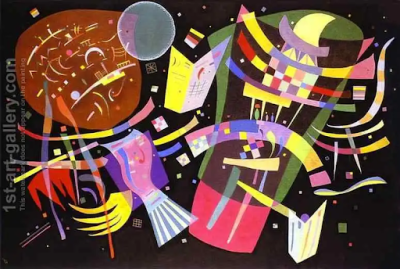Mathematics is not the only place where geometric shapes matter. Geometry belongs in art too. In fact, some of the fascinating paintings and pictures are famous geometric art created with shapes of different sizes, colors, and mediums.
Let’s dive deep into knowing more about:
- What are Geometric Paintings?
- Painterly Realism of a Football Player – Color Masses in the 4th Dimension
- Composition II in Red, Blue, and Yellow, 1930
- Wassily Kandinsky, Composition X, 1939
- Henri Matisse, Beasts of the Sea, 1950
Table of Contents
What are Geometric Paintings?
Geometric paintings are drawn with lines and points to create shapes like circles, squares, and triangles. Several movements arose from the use of geometric shapes in art. Art movements that use geometric unique shapes in their paintings and drawings include cubism, bauhaus, vorticism, and futurism.
Geometric artists create art with shape painting or pictures made from shapes. Below, we’ll go over some geometric shapes painted by famous geometric artists.
Painterly Realism of a Football Player – Color Masses in the 4th Dimension by Kazimir Malevich (1915)
‘Malevich Painterly Realism of a Football Player is a dynamic and bold composition and one of the most important geometric shape paintings. It was one of the paintings exhibited at the 0.10 (Zero-Ten) The Last Futurist Exhibition of Paintings, an influential exhibition.
Aiming to push the already established notions of cubism and futurism to their limits and to find the ground zero of art, Kazimir painted a collection of works that he presented as an entirely new system of art called Suprematism. According to him, this style removed all semblance of the natural physical world as we see it.
Instead, he focuses on the relationship between shapes, their colors, and how they relate to the blank white background. Painterly Realism of a Football Player – Color Masses in the 4th Dimension is one such painting within this scale of art.
The subtitle relates to the theory of the fourth dimension in mathematics. Many artists in the 20th century used this theory to justify their representation of their truth apart from the usual sensory perception.
Composition II in Red, Blue, and Yellow, 1930 by Piet Mondrian
Piet Mondrian was an art theoretician and painter. He was known for his abstract paintings of significant beauty and is considered a major proponent of the Dutch abstract art movement of De Stijl (“The Style”).
Before he began getting involved in geometric abstract painting, his style leaned more towards The Luminists and post-impressionism before he was introduced to geometric cubist ideas through the works of Georges Braque and Pablo Picasso. However, he was so impressed that he moved to Paris in 1912 and began incorporating the geometric art style into his works.
Composition II in Red, Blue, and Yellow was one of Piet’s works he produced in an attempt to turn his style into abstract geometric art and achieve complete abstraction. In addition, he believed he could use neoplasticism, also called plastic arts, to express universal purity.
Piet Mondrian wrote academically about compositional harmony in his quest for balance in how it works. He also examined how colors are placed, shape sizes, and the surface quality he worked on. He did all this hoping to reach a stillness in his works.
This painting stands its ground as an established example of famous geometric art through the second half of the 20th century and even influences parts of pop culture in this generation. The balance he sought to achieve was well executed in this painting.
The painting features a tiny yellow rectangle from the bottom of the canvas, a big red square contrasting the bold, broad lines, and the blue meeting the red. It’s obvious that this painting was carefully executed.
Wassily Kandinsky, Composition X, 1939

Many artists dabbled in philosophy and theories of art. Wassily Kandinsky was one such artist. He was a Russian painter and an art theorist who was an early adopter of abstract art and painting.
He co-founded the Phalanx and The New Group of Artists, leaving his footprint and influence on the art world, particularly in abstraction. Under these platforms, he staged exhibitions for his colleagues as a working artist.
Throughout his artistic career, Kandinsky painted over 600 artworks. A 1913 painting was auctioned in 2017 for a record-breaking price of $41.6 million. However, all these achievements pale beside his Composition X, his most stellar work.
To round up his study into the purity of expression and form, the geometric artist began a lifelong series of abstract compositions, including some with geometric styles. Composition X was the last in this series.
Before Composition X, Wassily Kandinsky used the color black sparingly in his paintings. However, art critics opine that the use of black in this painting foreshadows his impending death and the evocative nature of the cosmos.
Henri Matisse, Beasts of the Sea, 1950
Henri Émile Benoît Matisse was a French visual artist. He was a famous geometric artist who played with shapes and colors by cutting paper into shapes and pasting them on plain white sheets mounted on a canvas.
Beasts of the Sea, Les bêtes de la Mer in French, is one of Henri’s most popular geometric shapes. It is also among the last of his works before he died. Beasts of the sea is an excellent example of his cutout art.
Beasts of the sea is a paper collage on canvas art completed in 1950 before he stopped his paper cutout paintings due to poor health. It is displayed at the National Gallery of Art in Washington, DC.
The Snail is another Matisse geometric shapes art made out of blighty colored paper cutouts. If you look closely, you’ll realize that the shapes within this artwork are positioned like a snail shell.
Conclusion
Beautiful art comes in different forms, including human, animalistic, and abstract. In the case of famous geometric art, it comes in jagged solid shapes of abstraction like Kazimir Malevich or even colorful pictures made from shapes and paper cutouts like the works of Henri Matisse.
















